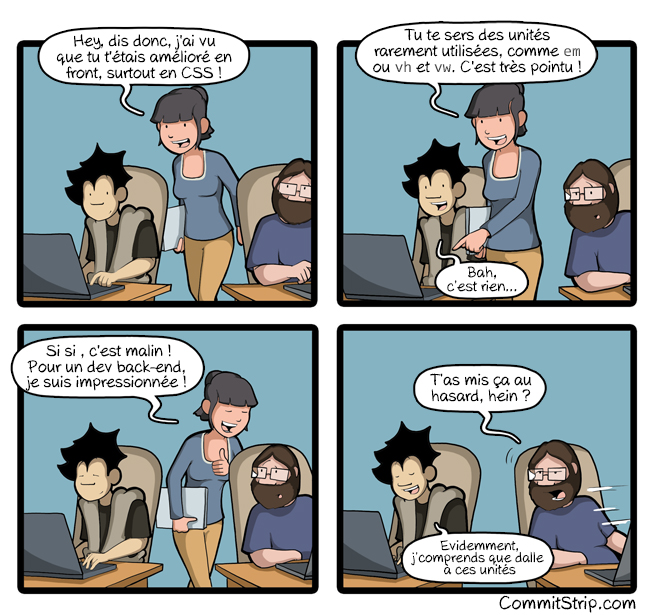⚠️ Cette présentation a été réalisée pour un environnement spécifique, aucun effort n'a été effectué pour qu'elle fonctionne correctement dans les autres navigateurs. J'ai utilisé Chrome Canary pour réaliser ces slides
$ whoami
Igor Laborie
⚠️ Je ne suis pas un designer
When designing computer systems, one is often faced with a choice between using a more or less powerful language for publishing information, for expressing constraints, or for solving some problem. This finding explores tradeoffs relating the choice of language to reusability of information. The "Rule of Least Power" suggests choosing the least powerful language suitable for a given purpose.
Règles du jeu
- Texte
- HTML & CSS
- SVG
- JavaScript
⚠️ ... mais il y a toujours de bonnes raisons pour ne pas suivre ces règles
Le CSS c'est vaste
- Selectors
- Box model
- Float
- Media Query
- Transitions
- Gradients
- Responsive Design
- Media
- Variables
- Colors
- Shapes
- @supports
- ...
Roadmap
- Utiliser un pré-processeur ?
- Unités,
calc() - Pseudo éléments
- Animations
- Pseudo classes d'états
- Pur HTML ?
Utiliser un pré-processeur ?
Pré-processeurs ?
Oui, mais privilégiez:
- le CSS
- les post-processeurs
Unités, calc(), et flexbox

Unités de longueur
- px, cm, pt, ...
- longueurs absolues (mesure physique)
- em, rem
- fonction de la
font-size - ex, ch
- hauteur d'un
x, largeur d'un0 - vh, vw
- (100vh, 100vw) = (hauteur, largeur) du viewport
- vmin, vmax
- min(1vh, 1vw), max(1vh, 1vw)
Holy Grail Layout
<body>
<header>Header</header>
<div>
<nav>Menu</nav>
<main>Content</main>
<aside>Side</aside>
</div>
<footer>Footer</footer>
</body>
Unités et calc()
flexbox
Pseudo éléments
<div class="table">
<div class="plate"></div>
</div>
- The :before and :after pseudo-elements
- mais aussi
::first-letter,::first-line,::selection,::backdrop - An Ultimate Guide To CSS Pseudo-Classes And Pseudo-Elements
⚠️ ::before et ::after ne marchent pas sur input, img, iframe (pas encore spécifié)
- Table et assiette de CSS Diner
- Dîner des philosophes
Animations
Pseudo classes d'états
:target,:hover,:focus,:empty, ...- Pour tous
:visited,:link, ...- Pour les liens
:checked,:valid,:invalid, ...- Pour les inputs
The science of operations, as derived from mathematics more especially, is a science of itself, and has its own abstract truth and value.
<label for="switch1">Switch</label>
<input id="switch1" type="checkbox" class="switch">
<label for="switch1"></label>
.switch + label {
display: block;
position: relative;
padding: .1em;
width: 2em; height: 1em;
background-color: #ccc;
border-radius: 1em;
border: medium solid #2c233d;
transition: 0.4s;
}
.switch:checked + label {
background-color: #2c233d;
}
.switch + label::before {
display: block;
position: absolute;
content: '';
top: .1em; left: .1em;
width: 1em; height: 1em;
background-color: #fff;
border-radius: 50%;
transition: background 0.4s;
}
.switch:checked + label::before {
transform: translateX(1em);
background-color: #faf8f8;
}
The computer (or rather the software in it) was smart enough to recognize that it was being asked to perform more tasks than it should be performing. It then sent out an alarm, which meant to the astronaut, I'm overloaded with more tasks than I should be doing at this time and I'm going to keep only the more important tasks; i.e., the ones needed for landing ... Actually, the computer was programmed to do more than recognize error conditions. A complete set of recovery programs was incorporated into the software. The software's action, in this case, was to eliminate lower priority tasks and re-establish the more important ones ... If the computer hadn't recognized this problem and taken recovery action, I doubt if Apollo 11 would have been the successful moon landing it was.[26]
Principe onglets
<div class="tabs">
<input type="radio" name="tab" id="home">
<input type="radio" name="tab" id="projects">
<input type="radio" name="tab" id="about">
<nav>
<label for="home">Home</label>
<label for="projects">Projects</label>
<label for="about">About</label>
</nav>
<div data-for="home">Home page</div>
<div data-for="projects">Projects page</div>
<div data-for="about">About page</div>
</div>
Démo onglets
Pur HTML ?
<details>
<summary>Des détails</summary>
<p>Plus d'infos à propos des détails.</p>
</details>
Des détails
Plus d'infos à propos des détails.
<dialog id="diag">This is a dialog!</dialog>
Can I use
- IE 7+, Firefox, Chrome
- Pseudo classes (CSS3 selectors 93)
- IE 8+, Firefox, Chrome
::before,::after98- IE 9+, Firefox, Chrome
currentColor98background-origin98box-shadow98calc97vh, vw, ...97- IE 10+, Firefox, Chrome
flexbox98- Animations 98
Conclusion
- Utilisez du CSS pour simpifier le code
- Utilisez les pre/post processeurs
- HTML, SVG are Awesome !
- JavaScript, TypeScript could be Awesome !
Traitez le CSS comme du code
- Revue de code
- DRY
- Clean Code
- Single Responsibility Principle
- ...
http://bit.ly/CssAwesomeMiXiT
https://github.com/ilaborie/css-awesome
Pour apprendre
(Ctrl|Cmd) + Shift + i CSS Secret by Lea Verou
CSS Secret by Lea Verou- CSS sur MDN
- CodePen, JSFiddle, Dabblet, ...
- CSS Tricks, Smashing Magazine
- Podcast: Shop Talk Show
- CSS code smells